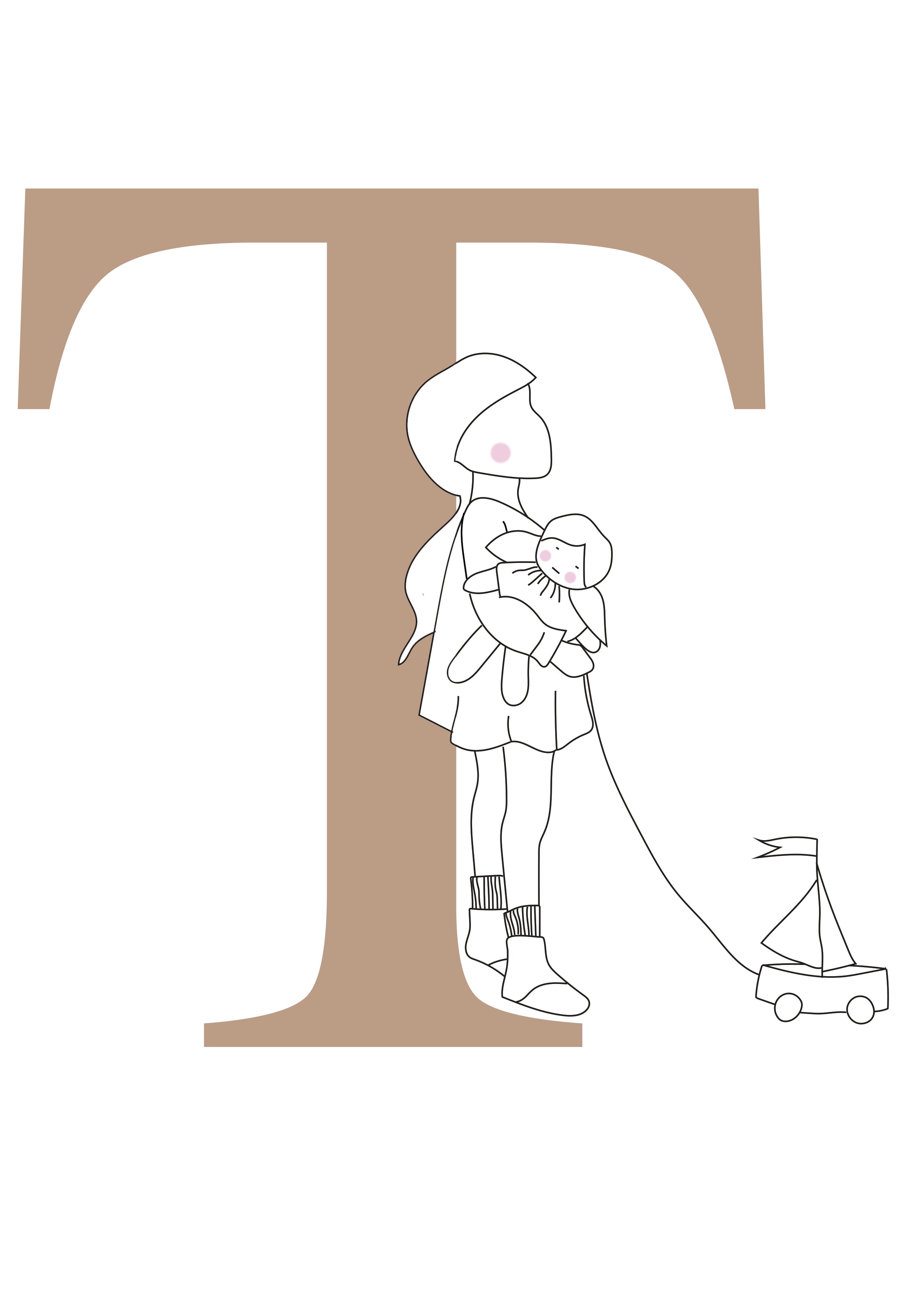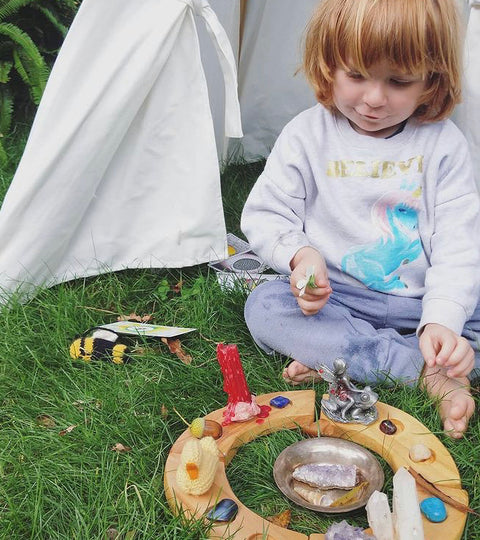By Amanda Bradley
With the rise of social media platforms like Instagram and Pinterest many people have been inspired by the beauty that accompanies the Waldorf (or Steiner) Education philosophy. How wonderful to see the rise in popularity of items made from natural materials, the value placed in handmade toys, and the ‘less is more’ approach to childhood being encouraged.

While these aspects are not specific to Waldorf Education (think Montessori, Reggio Emilia or many indigenous ways of being), they are certainly thought to be a major aspect to it. For this post I wanted to briefly explain the Why of the Waldorf aesthetic and some ways you bring this into your home no matter your budget.
The term ‘Waldorf’ comes from the Waldorf Education. Waldorf pedagogy (art of teaching and learning) holds a holistic view of the human being, that we are both material and spiritual beings, and that though our human-ness we strive to balance the two. I will do a post in the future going into this view of the human being in more depth. For now, let us hold a picture that the human being is made up of a physical body, and etheric (life force) body, a soul (astral body), and an eternal kernel (the higher self, ‘I’). Each of these bodies develop at different times and although they work together, they have ways of behaving that we can observe as the child grows older.
The themes of Goodness, Beauty and Truth are worked with at different stages as the child grows older (yet like the four bodies, they all weave together and work as one). For the first seven years we want to surround the child with an environment embodying the Good. Seven to fourteen we emphasize Beauty and between fourteen and twentyone we emphasize Truth. This is important to mention because these three ideals point to the Why of the Waldorf aesthetic.
Many people come to Waldorf when before their child hits high school, so it makes sense that they will be wanting to provide an environment that is both Good and Beautiful. But what is Good, and what is Beautiful? These are debatable terms, and will always be defined by culture and place. This is something to be mindful of, as I think in the past the Waldorf aesthetic has catered to a very westernized, European definition of goodness and beauty. While this does not need to be thrown out, we do need to have a think about how we move this into the current time and be sure to embody the cultural context we and our students/children are born into.
What is Good?
‘The moral compass’ is a term well known, but how is this created? In a Waldorf context this ‘compass’ is developed throughout childhood. In order for children to become the change makers and light bearers of the future, they need to have a sense of what is Good. So that when they see something not good, they can recognise it and change it.
Young children learn through sensory experience, movement and imitating their environment. So, you could tell a three year old what you think is good and what is bad, but much of that goes in one ear and out the other. Any behaviour changes will most likely be because of your actions and the emotional atmosphere, rather than the words you spoke.
What happens around them, and what their physical environment contains builds their sense of Goodness (their moral compass) particularly before seven.
This is why making nutritious food from scratch, caring for your home in a joyful way (chores), and ensuring the items/toys that are in your house are good quality and beautiful is important. Of course these are ideals. We have Lego and second hand plastic toys in our home. But to become mindful of the gesture behind what you present to a child goes a long way.
Think of the difference between a mass produced BRATZ doll, that has been made from unsustainable materials, in an environment where workers are possibly exploited, then they are transported across the world, to be opened and not made to last….Compared to a handmade doll (made by a parent, or a local small business owner), that is stuffed with local sheep’s fleece, made from natural or recycled materials, and it reflects the child it is made for. How different is that process for the planet and for your child? If we are holding the view that the human beings are both physical and spiritual beings, surely the child will sense the difference between these two items.

What is Beauty?
I would define beauty as a state of being that is both balanced and harmonious. So when you look at the beauty of a Waldorf kindergarten you will notice a large amount of natural toys, wooden blocks, shells, branches. There is also a harmony in terms of the colours used. They are soft and not over stimulating, lots of natural tones. This is to ensure the visual sense is not overwhelmed and allows the child to build a relationship with the natural beauty that we as humans are then able to enhance when we take raw materials and lovingly give them a shape, form or purpose.
Goodness and Beauty go hand in hand and of course Truth comes into this. Providing children with nutritious simple food and simple, well made toys, have an integrity about them. There is a sense of care and consideration not only for the child, but of the maker of their food/toys and the environment.

Ways to bring the Waldorf aesthetic into your home in a way the embodies Goodness, Beauty and Truth.
• Nature ‘toys’
When going on a hike, or playing at the beach look around for items that are beautiful and can become more than what they are. Children can transform shells, stones and sticks into endless things. Cars, coins, swords, wands, blocks, animals, dolls, the possibilities are endless. These are free and eco friendly toys that can be given straight back to the earth when finished. They can be embellished and used for craft projects as well. ‘Loose Parts Play’ is on trend for good reason! Pick up some baskets from your local op shop to keep these in. Or better yet, weave your own baskets from harekeke (flax) or willow.

• Get Crafting
Tanglewood Toys supply some of the classic Waldorf Craft books that are packed with easy to follow patterns to create your own toy collection. Their craft kits are also a great place to start. You can also get books out from the library to test them out as well. Make toys that reflect your culture and whakapapa (heritage). There will be wonderful crafts that reflect your culture and place that may not be in these traditional Waldorfy books.
• Children Can Enjoy Chores
I swear! If they see them done with love and there are ways for them to participate. Use natural cleaning products like lemon juice, vinegar and essential oils so children can help clean surfaces. You can have a tub/sink set up after meals for them to wash their plate and cups. Get them making beds and tidying their toys. If they see you enjoying yourself they will want to get involved as well. It never hurts to sing while you are doing it. I often make up a song and just sing what I am doing.
As children get older singing will not encourage them to get involved (unless its to stop Mum and Dad singing…) so discuss with your older children the importance of being part of a community and that looking after the home is everyone’s work. Most fathers have evolved to know that men are just as responsible for a clean house as the mother, which is important for children to see. Chores are not automatically a mothers domain.
From about 12 years old children and young adults can take on greater responsibilities like meal planning, lawn mowing, budgeting and begin to contribute to discussions about modifying the way the household runs. Creating expectations early on will help older children and young adults maintain their contribution to a healthy happy home, regardless of bumps in the road.
• Ritual Around Meal Times
Set the table with your young child or allow older children autonomy in setting and decorating the table. Set up a candle in the middle of the table, and some fresh flowers if you have access to them. Say a verse or prayer (appropriate for your families religious/spiritual beliefs) before meals. This brings a moment of quiet and mindfulness before you eat together which cultivates reverence and respect for the food and the spiritual world which both nourish us.
Let whatever you decorate the table with, reflect the season or festival happening at the time. Meal times are a great time to connect as a family. I highly recommend Lou Harvey Zahra’s books which are all about connected parenting and bringing that Waldorf Vibe into your home in an authentic way.
• Inner Development of the Parent
Regardless of spiritual path or practice, we should be striving to better ourselves. Some people will do this by engaging in church study groups, some will practice yoga, some will learn transcendental meditation, some will become Anthroposophists, Buddhists, Shamans, Christians or Eclectic Magicians!
Regardless of your path becoming self-aware and finding ways to become a better person will be sensed by your child. For them to grow up around a parent who is always trying improve themselves and make the world a better place is most definitely a good thing. Enjoy it friends, life is an adventure and there is joy to be found in every moment.
~
I want to make it clear that everything I have written today I have done so knowing that every family is different, and every day is different. Some days we will craft, bake and sing with our children. Some days we will work all day and come home with takeaways. These ideals are here to inspire and encourage you, please never feel that you are failing if you don’t meet these at all times. Understanding the underlying values that inform what Waldorf parenting looks like will help elevate the guilt we can sometimes feel when looking at what others are doing. Because we know that a healthy happy childhood doesn’t depend on everything being perfect, rather that parents and teachers understand the spiritual and physical nature of the child and strive to provide them with the environment that will allow them to unfold into who they are meant to be.
About Amanda
Amanda Bradley (Ngāti Whakaue) is a mother, Waldorf Handwork teacher, hosts The Holistic Human Podcast, and is half way through her Masters of Education (focused on Waldorf Handwork). She has a passion for nature based, hands on, Waldorf education and feels like there can never be enough arts and crafts in a day! Follow her on Instagram for Waldorf based, spiritually oriented content, head over to her youtube channel for craft tutorials and check out her podcast for fun and enlightening chats.





1 Comment
HI Amanda,
I studied Waldorf Education a few years ago and have spent some time in my studies teaching at some amazing schools so am familiar with the pedagogy and ethos. I have recently had a child of my own and am reading up on environments and materials etc. gosh I just wanted to say how much I enjoyed this blog post. it made me feel all warm inside as it took my memories right back to those special moments at the schools i taught in. thanks again. I look forward to purchasing from tanglewood.